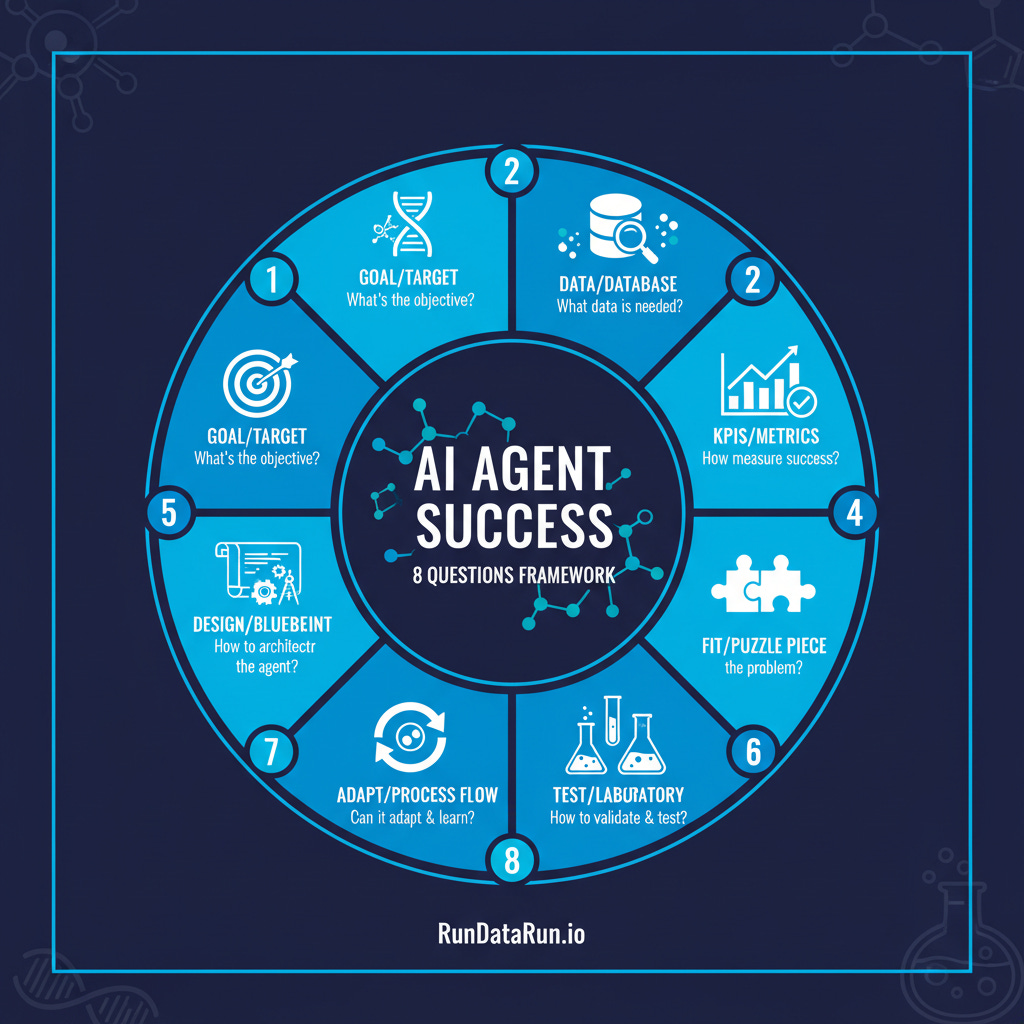The Agent Archaeology Checklist: 8 Questions That Prevent the 6 Most Common Agent Failures
Why 90% of AI agent projects fail—and the excavation toolkit that prevents it
Most AI agent projects don't fail because the technology doesn't work. They fail because teams skip the archaeological dig into their own processes, data, and organizational readiness before deployment.
Think of it as agent archaeology - systematically excavating the layers of your business to uncover what's really needed for AI agents to thrive. The companies getting 35% productivity gains and 20-30% cost reductions from AI agents aren't just lucky. They're asking the right questions before they build.
Here's your excavation toolkit: 8 critical questions that prevent the 6 most common agent failures plaguing 90% of implementations.
The Brutal Reality of Agent Failures
Before we dig into solutions, let's face the uncomfortable truth. Recent research paints a sobering picture:
90% of AI agent implementations fail within six months (Beam.ai analysis, 2025)
42% of companies abandoned most AI initiatives in 2025, up dramatically from just 17% in 2024 (S&P Global)
95% of enterprise AI pilots fail to deliver expected returns (MIT research)
40% of agentic AI projects will be canceled by 2027 due to escalating costs and unclear business value (Gartner)
The pattern is clear: the technology works, but the implementation approach is fundamentally broken. Most failures stem from six predictable categories that proper archaeological work can prevent.
The 6 Most Common Agent Failures
Enterprise Readiness Gaps - Rushing into AI without proper foundation
Training Limitations - Poor data quality and insufficient learning materials
Decision-Making Flaws - Unclear success metrics and accountability
Planning Breakdowns - Unrealistic timelines and scope creep
Engineering Barriers - Technical debt and integration nightmares
Fragile Collaboration - Human resistance and change management failures
Each failure type has a corresponding archaeological question that uncovers the real issues before they derail your project.
Question 1: Goal - Is this a valuable outcome to automate?
Prevents: Enterprise Readiness Gaps
This isn't about whether AI agents are cool. It's about whether automating this specific outcome creates measurable business value that justifies the investment and organizational change required.
🚩 Red Flag Example:
A biotech R&D team wants agents to "accelerate drug discovery" because they read about AI in pharma. No clear metrics, just "find compounds faster." When pressed for specifics, they can't define what acceleration means or how they'll measure discovery improvements.
✅ Green Light Example:
Clinical data management team identifies that 60% of adverse event reports require 45 minutes of manual coding and verification. Agent automation could save 180 hours/week, worth $9,000 monthly in clinical operations costs. Clear ROI: $108,000 annually vs. $25,000 implementation cost.
Archaeological Questions to Ask:
What specific business metric will improve and by how much?
What's the current cost of doing this manually?
How will you measure success in 90 days?
Who owns the budget and success of this outcome?
Question 2: Data - Do we understand the data and flow?
Prevents: Training Limitations
AI agents are only as good as the data they learn from. Most failures happen because teams assume their data is "good enough" without actually mapping the information architecture agents will need.
🚩 Red Flag Example:
Regulatory affairs team wants agents to automate submission preparation, but clinical data lives in EDC systems, manufacturing data in MES, and quality data in LIMS. No one knows which system has the authoritative version. Data formats vary by study, and 40% of datasets have missing regulatory identifiers.
✅ Green Light Example:
Pharmacovigilance team maps exact adverse event flow: MedWatch report → case intake → medical coding → causality assessment → regulatory submission. Data formats standardized across studies, error handling defined for incomplete reports. They know 85% of cases follow standard workflow, 15% need medical officer review.
Archaeological Questions to Ask:
Where does all the relevant data currently live?
What's the quality and completeness of this data?
How does information flow between systems today?
What happens when data is missing or incorrect?
Question 3: KPIs - Can we measure success clearly?
Prevents: Decision-Making Flaws
Without clear metrics, you can't tell if your agent is working or just creating expensive busy work. Vague goals like "improve efficiency" doom projects from the start.
🚩 Red Flag Example:
"We'll know the agent works when regulatory submissions get approved faster." No baseline metrics captured. Success defined as "fewer FDA questions" rather than measurable improvement. No way to distinguish between agent impact and regulatory guidance changes.
✅ Green Light Example:
Currently: 28-day average time from data lock to submission filing, 67% of submissions accepted without major deficiencies. Target: 18-day filing time, 80% clean submissions. Baseline established across last 12 submissions. Clear measurement methodology tracking both speed and quality metrics.
Archaeological Questions to Ask:
What's the current baseline performance?
What specific improvement targets are realistic?
How will you isolate agent impact from other variables?
Who reviews these metrics and how often?
Question 4: Fit - Can this be redesigned for agents?
Prevents: Planning Breakdowns
Not every process is agent-ready. Some workflows are too complex, too creative, or too dependent on human judgment. The key is identifying what can be redesigned vs. what should stay human.
🚩 Red Flag Example:
Medical affairs team wants agents to "handle investigator communications." Process involves complex scientific discussions, relationship management, and strategic decisions that vary wildly by study protocol and investigator expertise. No clear rules or patterns to automate.
✅ Green Light Example:
Clinical trial monitoring team redesigns site activation into standardized steps: regulatory document collection → site qualification verification → contract execution → study startup. 75% of sites follow identical process with clear decision trees for common qualification scenarios.
Archaeological Questions to Ask:
What percentage of cases follow predictable patterns?
Which steps require human creativity or judgment?
Can the process be standardized without losing value?
What would a "minimum viable automation" look like?
Question 5: Design - What roles do agents need to play?
Prevents: Engineering Barriers
Successful agent implementations clearly define what the agent does, what humans do, and how they hand off work. Fuzzy role definitions lead to technical complexity and user confusion.
🚩 Red Flag Example:
Clinical operations team wants an agent that "helps with patient recruitment." Unclear whether it screens eligibility, schedules visits, conducts pre-screening calls, or all of the above. No defined handoff points between agent and clinical coordinators.
✅ Green Light Example:
Drug safety case processing: Agent handles initial case intake and data extraction (automated), flags serious adverse events for medical review (escalation), generates draft case narratives (automated), medical officer reviews and approves (oversight). Clear swim lanes defined between automated processing and medical judgment.
Archaeological Questions to Ask:
What specific tasks will the agent own end-to-end?
When and how does work transfer between agent and human?
What decisions can the agent make autonomously?
How do you handle edge cases and errors?
Question 6: Adapt - How must the process change?
Prevents: Fragile Collaboration
Agents don't just automate existing processes - they require process redesign. Teams that try to bolt agents onto broken workflows get broken results.
🚩 Red Flag Example:
Quality assurance team wants agents to process deviation investigations but won't change their current 15-step approval process involving email chains and wet signatures. Agent gets stuck waiting for quality manager approvals that take weeks.
✅ Green Light Example:
Clinical trial startup redesigned from 45-day manual process to 12-day agent-assisted flow. Eliminated redundant regulatory document reviews, automated site qualification scoring, created digital approval workflows for standard protocols. Process improvement + automation.
Archaeological Questions to Ask:
What current process steps add no value?
How will information flow change with agent involvement?
What new tools or systems are needed?
How will you train people on the new process?
Question 7: Align - Who owns and sustains it?
Prevents: Fragile Collaboration
Agents need ongoing care and feeding. Without clear ownership and governance, they degrade over time or get abandoned when the initial champion leaves.
🚩 Red Flag Example:
IT builds an agent for regulatory submissions, but regulatory affairs doesn't understand how it works. When submission quality degrades, no one knows how to fix it. Original developer moved to another company. Agent becomes "ghost automation" that people work around during critical filing deadlines.
✅ Green Light Example:
Clinical data management team owns the adverse event processing agent with dedicated "clinical data agent manager" role. Monthly performance reviews, quarterly model retraining on new case types, annual capability expansion. Clear escalation procedures and maintenance budget allocated from clinical operations.
Archaeological Questions to Ask:
Who will monitor agent performance daily?
How will you handle agent errors or degradation?
What's the budget for ongoing maintenance and improvement?
Who makes decisions about agent capability changes?
Question 8: Test - Can we pilot and learn quickly?
Prevents: Planning Breakdowns
The best agent implementations start small, prove value, then scale. Teams that try to automate everything at once usually automate nothing successfully.
🚩 Red Flag Example:
Manufacturing team wants to automate entire batch record review process across 5 facilities simultaneously. No pilot phase, no learning period. When issues arise, they affect all production batches and create massive regulatory compliance disruption.
✅ Green Light Example:
Start with one product line at one manufacturing site for 30 days. Measure accuracy, speed, and regulatory compliance. Identify issues and fixes before expanding to additional products. Scale based on proven results and regulatory comfort, not assumptions.
Archaeological Questions to Ask:
What's the smallest valuable pilot you can run?
How will you capture and apply learnings?
What are your go/no-go criteria for scaling?
How quickly can you iterate and improve?
The Archaeological Mindset
The companies succeeding with AI agents aren't just implementing technology - they're conducting careful archaeological digs into their own operations. They're uncovering the hidden assumptions, broken processes, and organizational dynamics that determine whether agents thrive or die.
This archaeological approach takes longer upfront but prevents the expensive failures that plague 90% of implementations. When you excavate properly, you don't just deploy agents - you deploy agents that actually work.
Your Next Excavation
Before your next agent project, grab this checklist and start digging. The artifacts you uncover in your organizational archaeology will determine whether you join the 10% that succeed or the 90% that fail.
The technology is ready. The question is: are you ready to do the archaeological work that makes it successful?
Strategic Questions for Leaders:
Which of these 8 questions would have prevented your last failed automation project?
How might conducting this archaeological dig change your current AI agent roadmap?
What organizational artifacts are you avoiding excavating that could derail your next implementation?
Have you done the archaeological dig before your last AI implementation? What artifacts did you uncover that surprised you? Hit reply and share your excavation stories.




